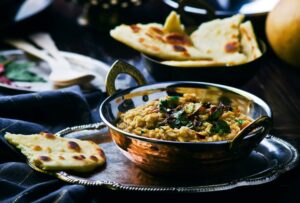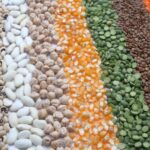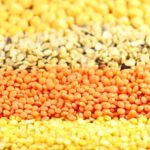Madras Lentils: A Guide to Cooking India’s Classic Comfort Dish
Madras lentils, often enjoyed for their robust flavor, are a hearty and nutritious dish originating from South India. This beloved comfort food combines lentils and red kidney beans, simmered in a spiced tomato-based sauce. My own experience with Madras lentils has taught me that they are not only a staple in Indian cuisine but have also found a place in the hearts of food enthusiasts worldwide. Thanks to their versatility, they can be customized with various ingredients and adapt to many dietary preferences.

Nutritionally, Madras lentils pack a significant punch. They are a dense source of protein and fiber, contributing to feeling full and satisfied after a meal. I’ve found that this dish perfectly aligns with a balanced diet, providing essential nutrients while still being a pleasure to eat. Whether served alongside flatbread or rice, or enjoyed as a standalone meal, the ways to cook and enjoy Madras lentils are numerous, each method bringing out a unique texture and depth to the dish.
Key Takeaways
- Madras lentils combine flavor with nutritional benefits, including high protein and fiber content.
- Originating from South India, this dish has a complex flavor profile and is adaptable to various ingredients.
- They’re a versatile meal option, suitable for pairing with other foods or enjoying by themselves.
The Origin of Madras Lentils and Their Cultural Significance

Madras lentils, also known as masoor dal in the Indian subcontinent, are a robust variety of lentils that form a cornerstone in the regional cuisine of Madras, now Chennai. Their rich, earthy flavor and soft texture when cooked make them an ideal candidate for the absorption of the myriad of spices typical to South Indian cuisine.
I find that the history of Madras lentils is intertwined with the culinary tradition of the region. These lentils are a testament to India’s agricultural diversity and have been nourishing the people of the Indian subcontinent for centuries. They’re not only a source of protein but also a key ingredient in the cultural tapestry of the area. Madras lentils feature prominently in celebrations and everyday meals alike.
In the context of Indian culture, lentils are more than just food; they represent sustenance and are often associated with various customs and rituals. The use of Madras lentils in dishes such as sambar and dal speaks to their versatility and ability to blend with the complex flavor profiles created by an array of regional spices such as mustard seeds, curry leaves, turmeric, and asafoetida.
The practice of tempering these lentils with spices, a cooking technique essential to many Madras lentil dishes, is crucial for releasing their aromatic flavors. My experience with these lentils reinforces their significance in Indian cuisine, where they’re often the main ingredient in wholesome meals, providing essential nutrients.
A deeper understanding of the cultural significance of Madras lentils underscores their role in fostering social cohesion, where sharing a meal signifies unity and togetherness. In essence, Madras lentils are not only a staple food item but also an embodiment of the regional identity and culinary heritage of Madras, reflecting a history of spice trade, colonial influences, and gastronomic innovation.
Nutritional Profile of Madras Lentils

Madras lentils, a delectable Indian dish, present a rich array of nutrients suitable for any balanced diet. They are an excellent source of protein, offering a substantial amount per serving, integral for muscle repair and growth.
I consider them a vital source of dietary fiber, significant for digestive health. Notably, the calories in Madras lentils are moderate, making them a favorable choice for individuals monitoring their energy intake. The fat content, predominantly unsaturated, contributes to a balanced diet while the cholesterol level in lentils is practically non-existent, which supports heart health.
The sodium content may vary depending on preparation methods; however, homemade recipes can be adjusted to reduce sodium for those concerned with blood pressure. Essential minerals such as iron and potassium are abundant in Madras lentils, with iron being crucial for oxygen transport in the blood and potassium aiding muscle and nerve function.
While not a significant source of vitamin C or vitamin A, the dish does contribute trace amounts that can complement an overall healthy eating plan. Moreover, lentils are recognized for their impressive profile of phenolic compounds, which display antioxidant activities beneficial for overall health.
| Nutrient | Benefit |
|---|---|
| Protein | Muscle repair, growth |
| Fiber | Digestive health |
| Calories | Energy provision |
| Fat | Supports a balanced diet |
| Cholesterol | Low impact on heart health |
| Sodium | Adjustable in recipes |
| Iron | Crucial for oxygen transport |
| Potassium | Supports muscle and nerve functions |
| Phenolic Compounds | Antioxidant activities |
In conclusion, the nutritional spectrum covered by Madras lentils positions them as a wise choice for those seeking a nourishing, plant-based meal.
Ingredients and Variations in Madras Lentils Recipes

Madras Lentils, or Tadka Dal, is a delightful Indian dish that requires a precise selection of ingredients to create its authentic flavor. I will guide you through the essential components and share how you can tweak the recipe for various dietary preferences.
Key Ingredients for Authentic Flavor
The foundation of Madras lentils is a harmonious blend of aromatics and spices. Here’s what I consider necessary for that authentic taste:
- Onions, Garlic, and Ginger: These are the aromatic base that starts the dish, providing depth of flavor.
- Tomatoes: Fresh diced tomatoes or tomato sauce create a tangy, rich base for the lentils.
- Cumin and Garam Masala: These spices are quintessential for adding the warming notes characteristic of the dish.
- Beans: A combination of red kidney beans and whole black lentils, known as urad dal, offer texture and protein.
Here is a basic list of ingredients for standard Madras lentils:
- 1 large onion, finely chopped
- 4 cloves garlic, minced
- 2 Tbsp grated ginger
- 1 tomato chopped or ¼ cup tomato sauce
- 1 tsp cumin
- 2 tsp garam masala
- 1 cup beans (mix of red kidney beans and black lentils)
- Salt to taste
Variations for Dietary Preferences
Madras Lentils are incredibly versatile and can be modified to cater to different dietary needs.
For a vegetarian or vegan version, use water or vegetable broth in place of chicken stock, and opt for coconut milk or a vegan cream substitute instead of regular cream. This not only maintains the creamy consistency but also adds a slight coconut undertone that complements the spices beautifully.
In contrast, if there’s a preference for a more rich and indulgent dish, traditional cream can be used to enhance the texture and flavor. Adding a dollop of butter or substituting ghee for oil can also enrich the dish.
For those looking to add a fresh element, a garnish of chopped cilantro just before serving works wonderfully. It introduces a pop of color and a burst of herby freshness that cuts through the rich base.
In essence, regardless of dietary preferences, the core spices and aromatics remain central to achieving the characteristic flavor of Madras Lentils, while the liquid and cream elements are where most variations can occur.
Cooking Techniques and Serving Suggestions

In my exploration of Madras lentils, I’ve discovered that both traditional methods and modern cooking conveniences can yield delicious results. I always consider the appropriateness of cooking tools, whether I’m harking back to classic techniques or embracing the efficiency of today’s technology.
Traditional Cooking Methods
When I’m aiming for an authentic touch, I rely on the traditional method of simmering the lentils over a stovetop. I start by sautéing onions, garlic, and spices, to which I add the lentils and water or broth. Cooking time typically spans over an hour, dependent on the desired tenderness. This slow-cooking process allows the flavors to meld beautifully. To complement the main dish, I often prepare a side of basmati rice or warm, buttery naan that pairs well with the robust flavors of the Madras lentils.
- Ingredients: Onions, garlic, spices, lentils, water/broth
- Tools: Pot or Dutch oven
- Cooking time: 1+ hour for ideal flavor fusion
Modern Cooking Convenience
For times when I’m short on hours but not on hunger, I utilize my Instant Pot for Madras lentils. This incredible kitchen gadget significantly reduces the cooking time without compromising on taste. The process begins much like the traditional method, with sautéing aromatics directly in the pot; then I add the remaining ingredients and set it to cook under pressure for a fraction of the time. While the Instant Pot does its magic, I might whip up a quick cilantro-infused side of rice or prep some naan for dipping.
- Ingredients: Lentils, aromatics, spices
- Tools: Instant Pot or Slow cooker
- Cooking time: 10-15 minutes under pressure
Health Benefits and Dietary Contribution of Madras Lentils
Madras lentils, as part of a plant-based diet, offer a wealth of health benefits. They’re an excellent protein source—a macronutrient crucial for tissue repair and muscle building. With protein-rich foods like Madras lentils, I can maintain a healthy and balanced diet.
In evaluating their dietary fiber content, Madras lentils stand out. Fiber is indispensable for digestive health, and it plays a role in managing blood sugar levels. Additionally, the heart benefits from a fiber-rich diet, with potential reductions in heart disease risk. By incorporating meals with Madras lentils, I increase my fiber intake significantly.
Madras lentils also associate with a healthy lifestyle. They’re low in fat and contain various nutrients that support overall wellness. Below is a brief overview of the nutritional profile of Madras lentils per serving:
| Nutrient | Contribution |
|---|---|
| Protein | High |
| Dietary Fiber | Excellent |
| Fat | Low |
| Carbohydrates | Balanced |
The convenience of preparing Madras lentils makes them an ideal component of a nutritious, plant-based meal. For those looking to expand their understanding of the health benefits of these lentils, the findings can be explored in-depth through scientific literature on PubMed.
In cooked dishes, Madras lentils provide not just texture and flavor, but also the peace of mind that I’m choosing a food that supports a healthy heart, contributes positively to my protein intake, and fosters overall well-being.
Frequently Asked Questions

In this section, I’ll address some common queries about Madras lentils, ranging from preparation methods to their nutritional profile.
How can I make Madras lentils at home?
To prepare Madras lentils at home, start by sautéing onions and spices in a pot. Then, add lentils and a tomato-based sauce and simmer until the lentils are tender. You can find an easy recipe here.
What ingredients are typically used in Tasty Bite Madras lentils?
Tasty Bite Madras lentils often contain cooked lentils, red beans, cream, salt, chili peppers, and spices. They’re known for their rich and robust flavor profile. More details can be found in this Tasty Bite copycat recipe.
What nutrition information is available for Madras lentils?
Madras lentils are generally high in protein and fiber but also contain calories and fats from the addition of cream and oil. Exact nutritional values can vary based on the recipe’s ingredients.
What are some recommended pairings to serve with Madras lentils?
Madras lentils pair beautifully with basmati rice, naan bread, or as part of a larger Indian-themed meal. They also work well with roasted vegetables or a simple salad for a complete meal.
Can you suggest ways to incorporate Madras lentils into other recipes?
Use Madras lentils in wraps, add them to salads for a hearty touch, or make them the base for delicious sloppy joes.Their versatility makes them a great component in various creative dishes.
Are there any health benefits associated with consuming Madras lentils?
Madras lentils are nutritious; they’re a good source of protein, essential vitamins, minerals, and dietary fiber, which can support heart and digestive health. You should consume them in moderation as part of a balanced diet, just like any other food.


 Previous Post
Previous Post Next Post
Next Post